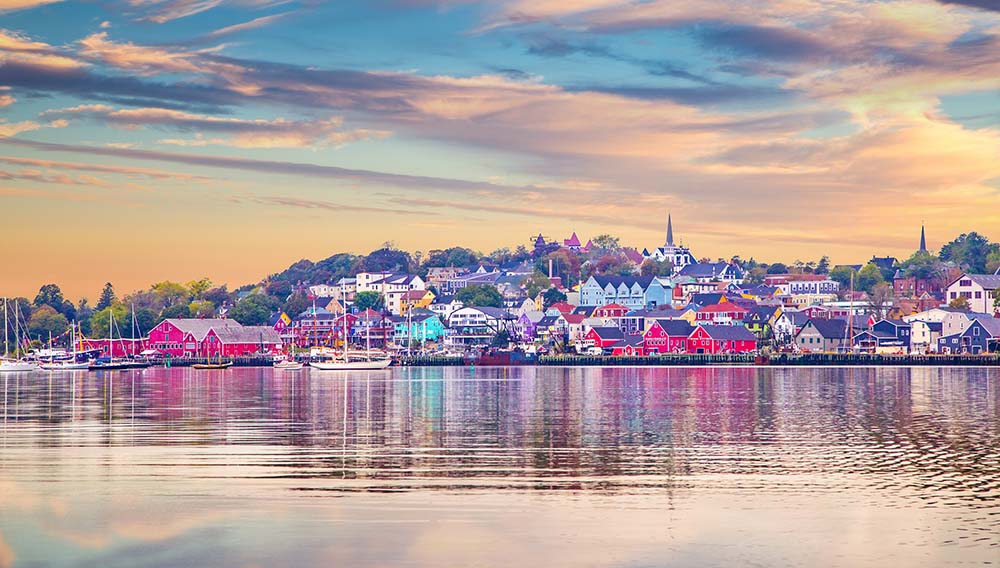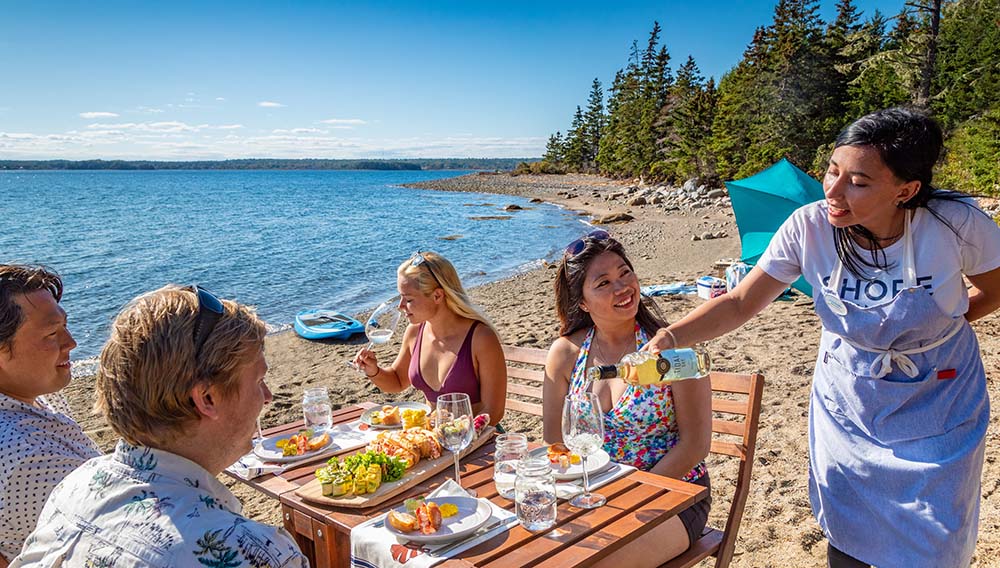Destination Canada is opening up our horizons by rail, road and boat from coast to coast to coast for jaw-dropping views, meeting welcoming locals and experiencing awe-inspiring encounters around every corner of Canada. Next stop: Nova Scotia. Let’s go!
Nova Scotia is unlike anywhere else in Canada. The east coast province harbours rugged towns and fishing villages, luring visitors with stunning lighthouses, uncrowded beaches and epic touring routes. Rich in Acadian, Gaelic and First Nations culture, you’ll meet colourful characters and see plenty of heritage sites.
There’s maritime history aplenty in Nova Scotia from shipbuilding to rum running and lobster fishing. Favourite pastimes include sampling fresh lobster rolls and long seafood lunches at waterfront eateries – and the best way to experience it all is on an autumn road trip for the fall foliage, delicious bounty and scenic attractions.
Fast and fun facts
- How to get there: Air Canada and Qantas fly direct from Australia to Vancouver with domestic flights available to the Nova Scotian capital, Halifax.
- When to go: For the ultimate autumn road trip, visit Nova Scotia during October. The summer months are best for whale watching with 12 whale species on show.
- Where is it? Nova Scotia is located in Atlantic Canada on the east coast of the country.
- Did you know? The Bay of Fundy experiences the world’s highest tides twice a day.
- Road-tripping: The 298km Cabot Trail through Cape Breton National Park is one of the world’s most scenic drives.
- Fun fact: It’s home to more than 150 lighthouses – more than any other province.
- Yum fact: Nova Scotia is Canada’s seafood industry capital with freshly caught lobster a specialty of menus province-wide.
With more than 50,000 tonnes of lobster hauled out of the ocean here every year, a seafood feast is the perfect way to experience a taste of Nova Scotia. Atlantic Canada’s culinary ambassador Alain Bossé aka The Kilted Chef explains why the local food is one of the best parts of a trip to the province.
Halifax

Start your road trip in Halifax, located in the middle of Nova Scotia and Atlantic Canada’s largest provincial city. Wander the 4km Halifax Waterfront boardwalk, one of the province’s most popular attractions, stopping in at interesting museums, seaside restaurants and boutique shops as you go. Venture around town on an I Heart Bikes guided e-bike tour or rent a bike for a DIY cycling adventure.
Halifax to Peggy’s Cove (45km)

Now that you have your bearings, put pedal to metal along Highway 333 to visit Canada’s most-photographed lighthouse, Peggy’s Point Lighthouse, jutting out into the Atlantic Ocean. Just one hour’s drive north of Halifax, Peggy’s Cove is a working fishing village famed for its picture-perfect profile of colourful houses along a narrow islet.
Peggy’s Cove to Lunenburg (49km)

More maritime history and quintessential architecture await in Lunenburg. Old Town Lunenburg is a designated UNESCO World Heritage Site – one of only two urban communities in North America – with a vibrant waterfront, narrow streets and colonial buildings. Embark on a guided Lunenburg Walking Tour to discover all the salty details of this lively port town.
Lunenburg to Wolfville (95km)

Head north, swapping coastal views for the Annapolis Valley, a region full of fall foliage, rolling fields, apple orchards and vineyards. Wolfville is the heart of Nova Scotian wine country and a great lunch stop on your way to the Bay of Fundy, which boasts the world’s highest tides. Here, the power of the ocean is on display with 150 billion tonnes flowing in and out of the bay twice daily. When the tide is out, the water level drops four storeys and you can even dine on the ocean floor.
Wolfville to Chéticamp (457km)

Hop back in the car for the five-hour drive to Cape Breton National Park with a pit stop in coastal Pictou – the birthplace of New Scotland (Nova Scotia). Continue north to the Acadian community of Chéticamp on The Cabot Trail, one of Canada’s most iconic road trip routes on Cape Breton Island.

Steeped in Gaelic and Acadian traditions, set aside at least five days to explore Cape Breton Highlands National Park. Hike the Skyline Trail boardwalks, spot whales and wildlife, meet the locals (‘Capers’) and, of course, eat Cape Breton lobster.
Chéticamp to Louisbourg (195km)

Drive 2.5 hours’ south, tracing the coastline to Louisbourg on Cape Breton Island’s east side. Explore colonial and indigenous history with the Fortress of Louisbourg National Historic Site and Mi’kmaw Interpretive Centre. If you have time, check out the Louisbourg Lighthouse or Old Town Trail for epic views of the Fortress.
Louisbourg to Halifax (222km)

Head south to Halifax via Antigonish, known as the ‘highland heart of Nova Scotia’ for staging the oldest continuous Highland Games in North America. With a relaxed, beachy vibe, the university town with Gaelic and Acadian roots is a top spot to break up the five-hour drive.

Conclude your road trip and deep-dive into Nova Scotian history with a rousing reenactment of 19th–century military activities at Halifax Citadel National Historic Site.
Sign up for the Canada Specialist Program

Take your Canuck knowledge to the next level and become a certified Canada expert.
Join the Canada Specialist Program (CSP) to learn more about the diverse landscapes and experiences, gain access to exclusive content and valuable tools to help you promote and sell Canada plus network with other agents via the closed Facebook group. Click here to sign up now!
Head here for extra info and inspo about Nova Scotia.
This article is brought to you by:







